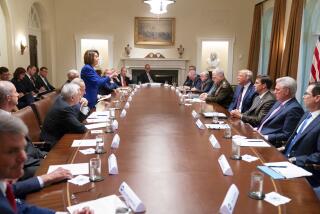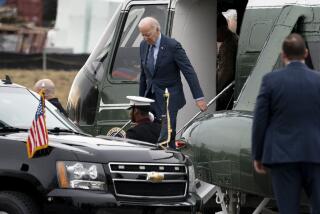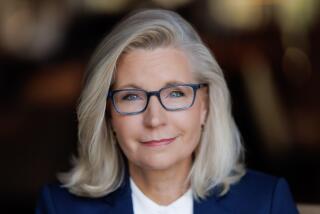First Lady Makes Influence Felt in Own Quiet Manner : White House: But she may emerge as a high-profile lightning rod for controversial liberal programs.
WASHINGTON — The members of Congress standing beside her beamed, but Hillary Rodham Clinton kept her hands folded, her tiny smile steady and her words restrained as she described a meeting with advocates of women’s causes that had just ended.
A new relationship, she said. Common concerns. Bipartisan effort.
Moments later, with the merest rustling as her entourage fell in behind, the First Lady glided from the pool of TV lights, off to more closed-door stops on her tour of the capital city’s power grid.
In the month since she declared her intention to become the most publicly powerful First Lady ever, Hillary Clinton has moved steadily, unmistakably to exert her influence. And she has done it in a manner all her own--quietly, elusively, almost mysteriously.
She has tightened her grip on the White House health care task force that she chairs. She has left signs of her thinking--and her editing pen--on the economic plan her husband delivered to Congress. She has worked from the wings to install former colleagues and allies in the top ranks of the Administration.
And week by week, while the pace of her public appearances increased, she has remained a distant, shrouded figure--the antithesis of her husband, who constantly uses television to thrust intimacy on even his most reluctant constituents.
Thus far, she appears to have avoided the public backlash that some predicted against an unelected First Lady who assumed an important role in policy-making. Los Angeles Times polling data, for example, indicate public approval for Hillary Clinton is strong--as strong as Nancy Reagan’s was at this point in President Ronald Reagan’s first term.
Yet for all her effort to keep her profile low, in the months ahead Mrs. Clinton may become a symbol--and lightning rod--for the powerful crosscurrents that run just below the surface of the new Administration:
Politically, the President is working to portray himself as a new kind of Democrat, a leader whose programs will be more directly responsive to the concerns of the broad center of the American electorate. When it comes to new spending for social programs, however, the priorities of the Clinton economic plan often appear remarkably similar to those of the old-fashioned liberals whose causes Hillary Clinton has long championed.
And if that becomes a political issue in an era of tight federal budgets, some of the criticism may fall to the First Lady.
For the moment, those larger concerns are overshadowed by fascination with her sheer elusiveness in a ground-breaking role.
“She’s out there, you see her, and yet you don’t have sense of her--what she’s like,” says Sheila Tate, press secretary to Nancy Reagan. “A sense of personality, I think, is still missing.”
Some of what is missing may become clear as Mrs. Clinton continues to carry out her most important policy assignment, leading the White House health care task force, which has burgeoned into an organization of 28 committees and 400 experts, consultants and others.
Officially, Mrs. Clinton’s role is that of a sort of facilitator, an emissary to the outside world, and student of health care.
She has been reading up on the issue until late into the night, and been tutored on its intricacies from such specialists as Susan Blumenthal, formerly of the Children’s Defense Fund. In meetings--she’s already made five trips to Capitol Hill--she has sometimes deferred on detailed questions to Ira Magaziner, the Clinton chum and business consultant, who devised the committee’s procedures and controls its paper flow.
In public statements, she strives to keep them guessing. Will the reform involve new taxes? a reporter asked last week. “We’ll reveal that to you as we reach decision points,” she replied.
But in the group’s private councils there seems to be no question where power resides.
As committee members were insisting this month that all options were open, Mrs. Clinton was rejecting as politically dangerous the idea that employee health benefits be taxed in order to encourage consumers to be more prudent in going to the doctor. “This suggests she has a tremendous amount of authority,” said Gail R. Wilensky, a health economist who was the George Bush Administration’s top expert on health and welfare.
Some members of Congress have seen in her remarks hints that she knows the plot-line of the task force script, because she is writing it.
After a recent meeting with Mrs. Clinton, Rep. Nancy L. Johnson (R-Conn.) was impressed. But she was also worried that the committee seemed to be leaning toward use of global budgets--caps on total health care spending--to control costs.
“The signal was there, and the idea concerned me very much,” said Rep. Johnson, who fears over-regulation could cause havoc in the health care system.
Indeed, Mrs. Clinton’s obliqueness has been unsettling to some members of Congress who have held sway over the issue in the past. “You give a lot of input on your concerns, it gets taken down, and then, where does it go?” asks one member of Congress, who wanted to remain unidentified. “This has become a big guessing game.”
Another Hill Democrat who has met with Mrs. Clinton is even more unhappy, saying she and top aides--whom he derided as “theologians” on the subject of health care--are “being very solicitous, but it’s also very patronizing. They haven’t asked us anything (substantive). ‘Are you happy? Are we returning your phone calls?’ It’s like being in the biosphere.”
Health care is Mrs. Clinton’s main charge, but there have been new signs each week that her role as a policy adviser will not be limited to health care.
She was not part of the war council that met in the Roosevelt Room of the White House for days earlier this month to thrash out the economic plan. But she did not need to be there to have her say on the address to Congress that laid out the blueprint.
Robert E. Rubin, chairman of the White House’s National Economic Council, was in a meeting the afternoon before the President’s speech when he received a note from Mrs. Clinton. The meeting was over, he announced, and headed off to hear her suggestions about simplifying some language he had written into the address.
Some analysts saw the hand of Mrs. Clinton and her former associates at the Children’s Defense Fund, on whose board of directors the First Lady served for many years, in the economic plan’s call for higher spending on domestic social programs. Among these were the proposals to spend more on the so-called WIC nutritional program, the Head Start program for preschoolers, the universal children’s immunization program and women’s health research.
It is this kind of spending that could become a political problem. Already, some Republicans are charging that beneath the rhetorical skin, Bill Clinton is an old-fashioned liberal--raising the taxes of the middle class to finance programs, these critics suggest, that disproportionately benefit minorities and the poor.
The economic plan “confirmed suspicions about the central influence of Hillary Clinton and (Children’s Defense Fund President) Marian Wright Edelman,” said Burton Y. Pines, a conservative commentator and think-tank president.
White House aides say these ideas are not Mrs. Clinton’s alone, but have long been shared by the President.
Still, while her identity remains undefined, these questions about Mrs. Clinton’s influence on her husband could pose a problem.
“If she is seen as Clinton’s emissary to the liberal groups, while he governs from the center, there may be no problem,” says Stephen A. Salmore, a political consultant and Rutgers University professor.
But if she emerges as the liberal’s lobbyist to Clinton, and a force driving Clinton to the left on controversial social issues, “it could threaten his effort to line up a majority. This is a President who got 43% of the vote. He’s got to focus on getting and holding that extra 7%,” he said.
One sign of White House concern on this point may have been her comments in a recent interview with Newsweek--one of only two interviews she has given since the inauguration. Seemingly to challenge this image as a liberal, she said she shares the President’s views on welfare reform. Specifically, she said she shares his conviction that welfare recipients should receive help and job training for two years, but should then end their dependence.
Mrs. Clinton has acknowledged that she had a voice in the choice of some Cabinet selections. More recently, her influence seems evident in the appointment of lawyers from the Rose Law Firm, where she worked, to White House slots.
Vincent Foster Jr., deputy counsel to the President, is from the firm, as is William H. Kennedy III, associate counsel. Webster L. Hubbell, Rose senior partner and a friend and golf partner of Bill Clinton, came to Washington during the transition to act as the White House’s liaison to the Justice Department.
As she has moved carefully behind the scenes, Mrs. Clinton has kept tight control over her public image.
Her meetings with the press, though regular, are most often brief appearances at scheduled photo sessions that rule out any lengthy questioning. Notably absent are the kind of highly personal encounters that her husband seeks out.
When Chelsea Clinton made her nationwide TV debut Feb. 20 on an ABC-TV Saturday show with her father, Mrs. Clinton did not appear. And when the photographer Annie Leibovitz took shots of the President, his friends and top aides for a Vanity Fair layout, only Hillary Clinton, of the inner circle, seemed to be absent.
The one newspaper interview she has allowed since the inaugural was devoted to discussion of her social role at the White House.
Is this because the campaign left her bitter toward the press, or that she fears to steal the spotlight from the President’s economic plan? Neither, say White House aides, who assert Mrs. Clinton’s life has become very public, and will be more so.
“You’ll see a lot more as we move ahead,” said one aide.
One recent public outing was revealing. In a speech Feb. 21 to the Eleanor Roosevelt Society, Mrs. Clinton talked of her aspirations in her current position, and acknowledged some of the sense of grievance she felt during the presidential campaign.
As she read up on Mrs. Roosevelt during the campaign, she said, she would imagine asking her questions: “How did you put up with it? How did you go on, day to day, with all the kinds of attacks, criticism that would be hurtled your way?”
For the moment, at least, the public isn’t directing much criticism Mrs. Clinton’s way.
A Los Angeles Times survey of 1,273 people on Feb. 18 and Feb. 19 found that Mrs. Clinton had a 56% approval rating, with 21% disapproving.
Her recent appearances have shown again her diplomatic side, as well as her lawyerly ability to speak in complete sentences before the cameras. “She shows a tremendous grasp of the issues, both politically and substantively,” said Rep. Henry A. Waxman (D-Los Angeles), who chairs a health subcommittee and met last week with Mrs. Clinton.
She has also revealed a bluntness that sets her apart from many professional politicians, perhaps including her husband. Visiting a restaurant in Hyde Park, Mass., a working class suburb of Boston, Mrs. Clinton used the harshest kind of language on the insurance companies that would not cover a diabetic man she met.
“It’s like we should all drop dead without ever going into the hospital,” she told the man.
While much of her private life is screened from public eyes, there are intimations about the strains of her workload, and difficulty of living in the artificial confinement of the White House--a place her husband has called the “crown jewel of the federal penal system.”
Chafing at the isolation, she sometimes takes off in the three-car motorcade in which she travels, simply to escape. Once, returning from Chelsea’s school, mother and daughter couldn’t resist the urge to wander the aisles of a supermarket.
They stopped at the Giant supermarket on Wisconsin Avenue in Washington. But at the check-out counter, they discovered they had no cash and that the grocery wouldn’t take a personal check. They left empty-handed.
According to schedule, on weekday mornings she sees Chelsea off to school between 7:30 and 7:45, then holds her first meeting, with her chief of staff and scheduler, between 8:30 and 9 a.m. She works until 7:30 p.m. or 8 p.m.
But after having dinner with the President and Chelsea, and sometimes helping her daughter with algebra or other homework, she resumes work, sometimes reading until the early-morning hours.
Speaking to a Boston audience about the health care work, she confided: “It’s been a month. It seems like 100 years.”
Staff writer Edwin Chen contributed to this story.
More to Read
Get the L.A. Times Politics newsletter
Deeply reported insights into legislation, politics and policy from Sacramento, Washington and beyond. In your inbox three times per week.
You may occasionally receive promotional content from the Los Angeles Times.











